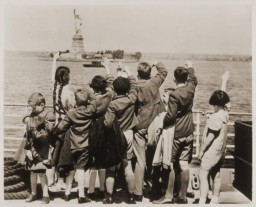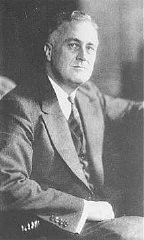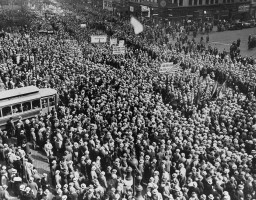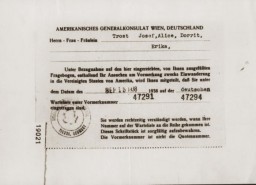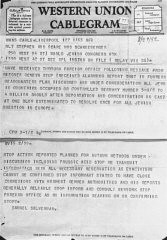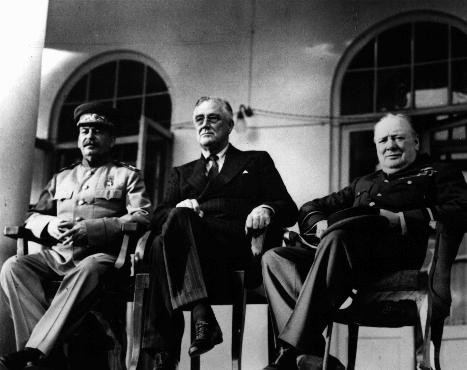
Franklin Delano Roosevelt
Franklin Delano Roosevelt was the 32nd president of the United States (1933–1945). He faced immense domestic and international challenges, struggling to restore an economy shattered by the Great Depression, respond to the worldwide threat of fascism and an international refugee crisis, move the nation from isolation to victory in a global war, and prepare the United States as a leader in the postwar world.
-
1
President Franklin D. Roosevelt took significant, yet limited, action, in response to the persecution of Jews in Germany, the refugee crisis in the 1930s, and the “Final Solution.”
-
2
Roosevelt prioritized economic recovery from the Great Depression and victory in World War II above humanitarian crises overseas. There was very little public pressure from the American people or from the US Congress to take action to increase immigration or to rescue European Jews.
-
3
Roosevelt's legacy regarding the Holocaust remains controversial, both in history books and among the general public.
Introduction
Franklin D. Roosevelt (1882–1945) was born in Hyde Park, New York, into a prominent family. Inspired by the career of his fifth cousin, US President Theodore Roosevelt, he entered politics after attending Harvard University and Columbia Law School. In 1905, he married his distant cousin, Anna Eleanor Roosevelt. The couple had six children, five of whom survived into adulthood.
Also known as FDR, Franklin Delano Roosevelt was elected to the New York State Senate in 1910 as a Democrat. President Woodrow Wilson appointed him assistant secretary of the Navy in 1913. In 1920, Democratic presidential candidate James M. Cox selected Roosevelt as his vice-presidential running mate, but they lost the election.
In 1921, FDR was stricken with a disease, likely poliomyelitis (commonly known as polio), and lost the use of his legs. For the rest of his life, he used a wheelchair and relied upon heavy iron braces, canes, and crutches. Despite this disability, Roosevelt re-entered politics and was elected governor of New York State in 1928.
Franklin Delano Roosevelt was elected President of the United States in November 1932 and inaugurated on March 4, 1933. FDR was the longest-serving president in US history. He was re-elected three times—in 1936, 1940, and 1944. FDR died in office on April 12, 1945.
Roosevelt and Early Reaction to Nazi Persecution of Jews
Roosevelt’s main focus in his first term was the “New Deal,” designed to lift the United States out of the Great Depression. In 1933, nearly 13 million people, about 25% of American workers, were unemployed. Putting Americans back to work and reviving the economy became key priorities for the Roosevelt administration. In his first inaugural address, FDR sought to calm, comfort, and encourage an American populace shaken and demoralized by factory closings, farm foreclosures, bank failures, and high unemployment by declaring, “the only thing we have to fear, is fear itself.”
Roosevelt was inaugurated only five weeks after Adolf Hitler was appointed Chancellor of Germany, on January 30, 1933. The new president was well-informed about the Hitler regime and its anti-Jewish policies.
New antisemitic laws and physical attacks on Jews in Germany were headline news in the United States throughout 1933. Thousands of Americans signed petitions or participated in marches, calling on the new Roosevelt administration to protest Nazi Germany. FDR, however, was cautious. Germany still owed American investors billions of dollars, borrowed to pay World War I reparations, and Roosevelt did not believe that the United States should intervene in the internal affairs of another country. He instructed the new ambassador to Berlin, William Dodd, not to make an official protest. Nazi persecution of German Jews, FDR supposedly told Dodd, was “not a governmental affair.”
During the 1930s (and throughout the Nazi period), the United States had no refugee policy, only a slow and careful immigration process that required applicants to provide extensive documentation about their identity, background, financial resources, and medical history. During President Roosevelt’s first term, tens of thousands of German Jews applied at American consulates to immigrate to the United States. Yet the Great Depression and restrictive American immigration laws severely reduced immigration opportunities for refugees.
Long before FDR became the president, the United States ceased to be a country of open immigration. Congressional legislation strictly limited the number of aliens who could be admitted to the country each year as immigrants. The 1924 US Immigration and Nationality Act established immigration quotas for each nation outside the Western Hemisphere. By 1929, the total number of immigrants legally permitted to enter the United States each year was set at 153,774. Nearly 50% of the slots were allotted to immigrants from Great Britain and Northern Ireland.
In September 1930, high unemployment in the United States led President Herbert Hoover to invoke a 1917 law with a “likely to become a public charge” clause, restricting immigration to people who could financially support themselves. This requirement effectively restricted immigration during the period of the Great Depression.
In 1933, and again in 1937, the Roosevelt administration modified the “likely to become a public charge” restriction, but kept it in place. German Jews attempting to immigrate to the United States in the 1930s were still often rejected for economic reasons.
As a result of these legal and administrative obstacles to immigration, less than 20% of the German quota was filled during FDR’s first term. The Roosevelt administration focused on domestic problems, chiefly combatting the Great Depression. Though Americans certainly had information about the threat Nazism posed to German Jews, few could have imagined the persecution would escalate to mass murder. FDR did not take significant action to aid German Jews, either by ordering a diplomatic protest or by publicly supporting increased immigration.
Roosevelt and the Refugee Crisis
As Nazi persecution of German Jews intensified throughout the 1930s, leading to a refugee crisis, Roosevelt took limited action to respond to the humanitarian emergency.
After Germany annexed Austria (Anschluss) in March 1938, tens of thousands of desperate potential immigrants added their names to the waiting lists for entrance to the United States. Shortly after the Anschluss, Roosevelt merged the German and Austrian immigration quotas, so that a maximum of 27,370 quota immigrants born in Greater Germany could immigrate to the United States each year. The quota was filled for the first time in 1939, and nearly filled in 1940 (27,355 visas were issued of an available 27,370). Yet by June 1939, more than 300,000 Germans were on the waiting list for American immigrant visas, and anticipated a wait of up to ten years.
Roosevelt also called an international conference, which opened in Évian-les-Bains, France, in July 1938, to discuss the refugee problem. Roosevelt hoped that the thirty-two participating countries would pledge to admit significant numbers of refugees, but that did not occur at Évian. The president also wanted to create an intergovernmental organization to negotiate with Nazi Germany for a peaceful immigration process. The Intergovernmental Committee on Refugees was formed after the Évian conference, but the continued unwillingness of the member nations to increase immigration (and, after September 1939, World War II) hampered their efforts. FDR also explored the idea of mass resettlement of Jews, possibly to Africa, South America, or elsewhere.
After the Kristallnacht attacks in Germany in November 1938, President Roosevelt expressed his shock “that such things could occur in a 20th century civilization.” He summoned the US ambassador in Berlin, Hugh Wilson, home for consultation. The United States did not have an ambassador in Germany again until after World War II. FDR also allowed between 12,000-15,000 Germans traveling in the United States on temporary visitor visas to remain in the country rather than forcing them to return to Europe. He used executive authority to grant a six month extension to the visas, and repeatedly extended the visas until the end of the war.
In February 1939, Senator Robert Wagner (New York) and Congresswoman Edith Nourse Rogers (Massachusetts) introduced bills proposing to admit 20,000 German refugee children into the United States outside the existing immigration quota. First Lady Eleanor Roosevelt spoke out publicly in support of the bill, but the president did not comment. The Wagner-Rogers Bill never moved out of committee to a floor vote. In June 1939, the President similarly did not intervene to permit the entry of the refugees aboard the St. Louis; doing so would have required an executive order or an act of Congress. The refugees were sent to Great Britain, France, the Netherlands, and Belgium after being turned away from Cuba.
Despite a building refugee crisis in Europe, FDR did not ask Congress to consider expanding the immigration quotas, even when presented with exceptional circumstances. Though Americans read about the persecution of German Jews in their local newspapers, few supported an increase in immigration, particularly while the country was still suffering the effects of the Great Depression. Some Congressmen introduced legislation that would reduce, rather than increase, the immigration quotas during this period.
When Nazi Germany invaded Poland in September 1939, sending European nations into World War II, Roosevelt vowed that the United States would remain neutral. After France surrendered to the Nazis in June 1940, a defeat that shocked Americans, many government officials and ordinary citizens believed that Nazi Germany had planted spies and saboteurs to bring France down from the inside. Many feared that Nazi Germany had already infiltrated the United States, too.
Rumors also circulated that Jewish refugees posed a particular threat, because the Nazis would be able to hold hostage their loved ones still in enemy territory unless the refugee worked on behalf of Nazi Germany. At a press conference on June 5, 1940, FDR reinforced these fears, stating, “Now, of course, the refugee has got to be checked because, unfortunately, among the refugees there are some spies, as has been found in other countries. And not all of them are voluntary spies—it is rather a horrible story but in some of the other countries that refugees out of Germany have gone to, especially Jewish refugees, they found a number of definitely proven spies.”
The State Department scrutinized all refugees as potential security threats, while hundreds of thousands of refugees still tried to navigate the complicated immigration system. FDR established the President’s Advisory Committee on Political Refugees to assist a few thousand prominent scholars, activists, and religious leaders in their immigration, and Eleanor Roosevelt frequently advocated on behalf of refugees. The ongoing war, break in diplomatic ties between the United States and Nazi Germany, and lack of passenger ships crossing the dangerous Atlantic Ocean soon made it incredibly difficult for any refugees to come to the United States.
Between 1939 and 1941, President Roosevelt worked very hard to prepare the United States for war. He promoted a peacetime draft, provided military supplies to Allies by passing the Lend-Lease Act, and slowly convinced the American public, who overwhelmingly did not want to get involved in the war, that it would be necessary to join the fight. He also ran, and won, an unprecedented third term as President. He did not spend his time or energy advocating for increased refugee immigration.
Roosevelt and the "Final Solution"
It is difficult to assess FDR's motivations as president since he did not keep a diary or detailed account of his thoughts. After Japan’s attack on Pearl Harbor in December 1941 and after Germany declared war, the United States formally entered World War II. Roosevelt and British Prime Minister Winston Churchill believed that defeating Nazi Germany should be the Allied priority. Allied leaders believed that winning the war was the only way to save democracy and to end Nazi terror against civilians, including Jews and the other victims. Rescue of civilians behind enemy lines would have been impossible for the Allies until late in the war, when very limited rescue measures were taken.
After the State Department confirmed in November 1942 that the Germans planned to annihilate Europe’s Jews, eleven Allied governments, including the United States, issued a declaration condemning the atrocities and vowing postwar punishment of the perpetrators. In December 1942, Roosevelt met with prominent figures in the Jewish community, who expressed their horror at the news and provided him with a report on mass murder in specific countries, but the president did not promise any new rescue action.
As the American people received more information about mass killing, public pressure led the United States and Great Britain to hold a conference in Bermuda in April 1943 to discuss rescue and relief. However, the Bermuda Conference did not lead to action, which increased the anger and frustration of American Jews and other interested members of the public.
In July 1943, Jan Karski, a prewar Polish diplomat and a member of the Polish resistance movement, met with Roosevelt. Karski described for Roosevelt what he had witnessed in the Nazi-established Warsaw ghetto. Roosevelt again did not commit to any specific action other than winning the war, but arranged for Karski to meet with other prominent government officials to share his story.
In January 1944, Treasury Secretary Henry Morgenthau Jr. and members of his staff presented FDR with evidence that the State Department had been obstructing even modest rescue and relief efforts in Europe. At the same time, Congress was debating whether or not to ask Roosevelt to appoint a rescue commission. To address both public pressure and pressure within his administration, FDR issued an executive order on January 22, 1944, establishing a War Refugee Board (WRB), an independent agency tasked with carrying out a new American policy to rescue and provide relief for Jews and other groups being persecuted by Nazi Germany and Axis collaborators.
The War Refugee Board took significant yet limited measures to rescue Jews and others trapped in Nazi-occupied Europe. They used psychological warfare tactics, sending radio broadcasts into Europe and dropping leaflets on occupied territory warning would-be perpetrators of postwar punishment. The WRB negotiated with neutral countries to allow refugees to cross their borders, assisted Jews escaping from Romania and Bulgaria to enter Palestine, and selected Raoul Wallenberg for a mission into Budapest. They also successfully convinced Roosevelt to open a refugee camp in upstate New York, Fort Ontario, where nearly 1,000 people, mainly Jews who had escaped to Allied-occupied Italy, were held for the duration of the war. In November 1944, the WRB released a report written by escapees from the Auschwitz-Birkenau camp, alerting Americans to the details of Nazi mass murder using gas chambers. The WRB calculated that they saved tens of thousands of lives in the final seventeen months of the war.
Roosevelt’s Death and the End of World War II
On April 12, 1945, Franklin Roosevelt died of a cerebral hemorrhage in Warm Springs, Georgia. That same day, Generals Eisenhower, Patton, and Bradley toured the newly liberated Ohrdruf concentration camp. Roosevelt did not live to see images of the liberation of concentration camps or the end of World War II. He was succeeded by his vice-president, Harry Truman.
Series: The United States and the Holocaust
Critical Thinking Questions
- How did domestic policies and priorities influence President Roosevelt’s responses to the threat to the Jews of Europe during his early terms of office?
- What pressures, motivations, and obstacles may have affected FDR’s choices during the Holocaust?
- Should a leader of a nation encourage the rescue of endangered populations elsewhere around the world? What obstacles and risks may impact decision-making?
